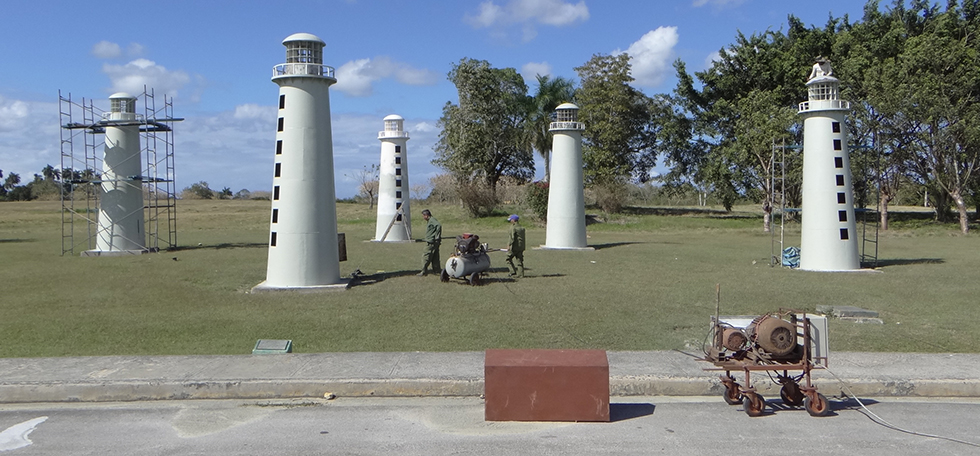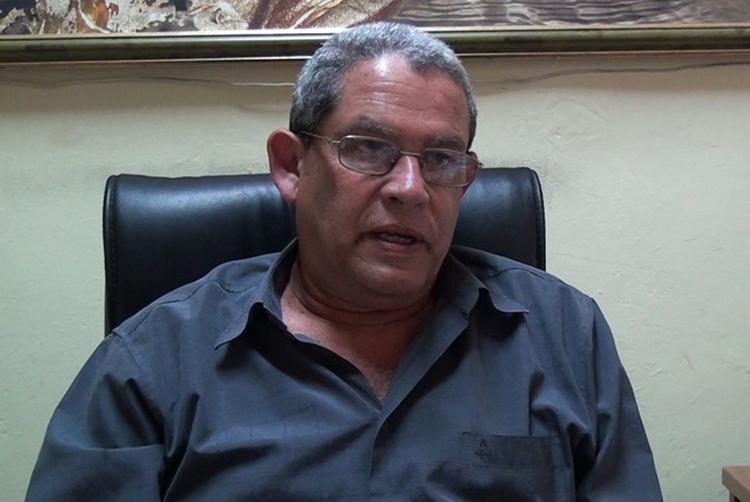At the moment the sculptural complex "Mundo de Faros" is restored, among other works in the Padro of the Sculptures, at the entrance of the main vial of the University. Photo: Alberto Medina Cruz.
Effervescence in restorations of art works.
When the University of Informatics Science (known as UCI) opened its doors, the Ministry of Culture, together with some of its institutions, promoted the artistic environment of the center, with the aim of training IT professionals, associated with a cultural active live. To this end, a group of artists were summoned to place their works in this house of high studies.
At the end of the thirteen years of having been located 27 original works and other reproductions began, at the end of 2016 the restoration of them. In search of answers, Mella newspaper interviewed the MSc. Ernesto Miguel García González, director of University Extension.
- How did the restoration process begin?
- The works already need to be restored because they have deteriorated to be in the open and take on all the negative effect of the environment: rain, sun ...
"That is the reason why, at the beginning of 2016, a process of contracting with the ATRIO Company of the Ministry of Culture begins, in order to begin the restoration of the works. We signed the contract in March, when we began to elaborate the technical opinion to evaluate the damages of each work and how much it meant its renovation budget.
"In May of the same year a technical meeting was held between the UCI and the ATRIO specialists. In September most of the artists visited the university, who also supported the restoration.
"On December 16th , the restoration of the works of the main road of the entrance of the University begins, which is known as Prado de las Esculturas, with the cleaning of the oxidation of Lighthouse World, Parto de las Formas, MPX-35 and Maternity, which are the first to be found at the entrance.
"Simultaneously, work begins on the murals that are in some of the educational buildings and in the Cultural Center itself, including Juan Vicente Bonachea (Cuando la muerte sedujo al maestro), which is found in teaching building named José Martí, who is already Completed. It is the first mural that was completely restored, and now works on the work of Setsuko Ono, titled Aspiration, found in teaching building 1. The rest is in the process of restoration.
- How much do these restorations monetarily imply?
- This project is in the budget order of about 170,000 CUC, which will be assumed from the concept that we have to save that heritage of the University.
- How important is it to the restoration of these works?
- It is really important because it is a cultural heritage, which in addition artists delivered in their time, between 2004-2006, and it is not at all pleasant to miss works of art.
"That is the reason why they are restored, carrying out in practice the concept of Fidel when I would say in the year 1993, during the Special Period, that culture is the first thing to be saved, because culture transmits ideas and thoughts Educates under this premise, this process has been initiated.
"Of course, each work has an appraisal put by the artist when it was placed, from the monetary point of view, but the most important thing is not how much is spent in the restoration; The most important thing is to save the cultural heritage, I reiterate, and that the generations of students, professors and workers of the University assume it as theirs.
- Artistic value of the works?
- We are talking about that the authors are artists of the Cuban plastic arts; Among them, there are National Prizes of Plastic Arts. They are outstanding and the entire university community must know them, because they are works of the Cuban artistic avant-garde.
"Many might think: there is much that it means from the economic point of view; But more important is the student's formation, with that broad culture to which the Revolution always aspires to train Cuban professionals: to learn about works of art, to learn to appreciate that artistic value that is there, which is also part of the material culture bequeathed to this university and that it must survive for many generations. "
- What would happen if works of art are not restored in time?
- If works of art are not restored in time, new students who enter the University are lost and later, and the new professors and the generations that pass through it will not know that there was a Prado de las Esculturas, A Mella square, a Niemeyer Square with an emblematic work by that author, a work by an Italian artist in front of the polyclinic (Mike Rosseto), a work by another foreign artist (Setsuko Ono).
- A message to the community.
- That professors and students, through their groups of brigades, and workers through the trade union sections, can visit these places and appreciate what they mean, including also those found in the Cultural Center, most of which are original, Like the work of Lescalle in the center of Plaza Lam, the murals that surround and are inside the Cultural Center itself, are also original works that will be restored.
- When is the restoration expected to conclude ?
- The restoration time can be in the order of a full year. Our aspiration is for the fifteenth anniversary of the university to be completed. We are talking, late November, maybe December 2017.
"But it is a long process, it requires a lot of materials, work force, delicacy, many particular elements that must be touched in each work because the time they were affected is considerable.
"We aspire to celebrate the 15 years with a better Prado de las Esculturas and with all the works restored as the artists have asked for.
"In conclusion, I would like to acknowledge all those who are supporting this restoration process, which is worth it, as Calviño would say."




